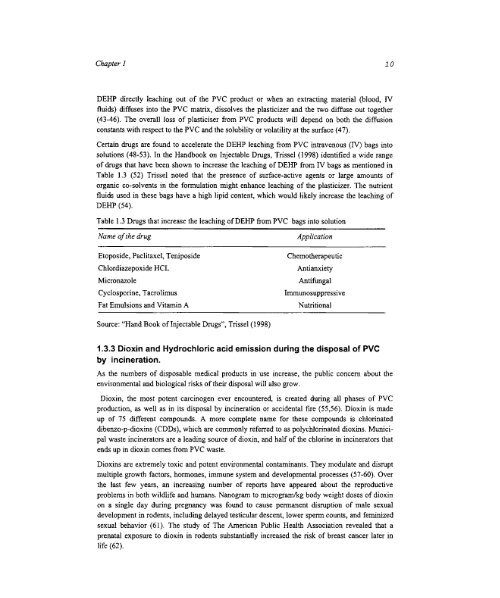Studies on Metallocene Polyolefin and Polyvinyl Chloride for Blood ...
Studies on Metallocene Polyolefin and Polyvinyl Chloride for Blood ...
Studies on Metallocene Polyolefin and Polyvinyl Chloride for Blood ...
Create successful ePaper yourself
Turn your PDF publications into a flip-book with our unique Google optimized e-Paper software.
Chapter J 10<br />
DEHP directly leaching out of the PVC product or when an extracting material (blood, IV<br />
fluids) diffuses into the PVC matrix, dissolves the plasticizer <strong>and</strong> the two diffuse out together<br />
(43-46). The overall loss of plasticiser from PVC products will depend <strong>on</strong> both the diffusi<strong>on</strong><br />
c<strong>on</strong>stants with respect to the PVC <strong>and</strong> the solubility or volatility at the surface (47).<br />
Certain drugs are found to accelerate the DEHP leaching from PVC intravenous (IV) bags into<br />
soluti<strong>on</strong>s (48-53). In the H<strong>and</strong>book <strong>on</strong> Injectable Drugs, Trissel (1998) identified a wide range<br />
of drugs that have been shown to increase the leaching of DEHP from IV bags as menti<strong>on</strong>ed in<br />
Table 1.3 (52) Trissel noted that the presence of surface-active agents or large amounts of<br />
organic eo-solvents in the <strong>for</strong>mulati<strong>on</strong> might enhance leaching of the plasticizer. The nutrient<br />
fluids used in these bags have a high lipid c<strong>on</strong>tent, which would likely increase the leaching of<br />
DEHP (54).<br />
Table 1.3 Drugs that increase the leaching ofDEHP from PVC bags into soluti<strong>on</strong><br />
Name ofthe drug<br />
Etoposide, Paclitaxel, Teniposide<br />
Chlordiazepoxide HCL<br />
Micr<strong>on</strong>azole<br />
Cyclosporine, Tacrolimus<br />
Fat Emulsi<strong>on</strong>s <strong>and</strong> Vitamin A<br />
Source: "H<strong>and</strong> Book ofInjectable Drugs", Trissel (1998)<br />
Applicati<strong>on</strong><br />
Chemotherapeutic<br />
Antianxiety<br />
Antifungal<br />
Immunosuppressive<br />
Nutriti<strong>on</strong>al<br />
1.3.3 Dioxin <strong>and</strong> Hydrochloric acid emissi<strong>on</strong> during the disposal of PVC<br />
by incinerati<strong>on</strong>.<br />
As the numbers of disposable medical products in use increase, the public c<strong>on</strong>cern about the<br />
envir<strong>on</strong>mental <strong>and</strong> biological risks oftheir disposal will also grow.<br />
Dioxin, the most potent carcinogen ever encountered, is created during all phases of PVC<br />
producti<strong>on</strong>, as well as in its disposal by incinerati<strong>on</strong> or accidental fire (55,56). Dioxin is made<br />
up of 75 different compounds. A more complete name <strong>for</strong> these compounds is chlorinated<br />
dibenzo-p-dioxins (CDDs), which are comm<strong>on</strong>ly referred to as polychlorinated dioxins. Municipal<br />
waste incinerators are a leading source of dioxin, <strong>and</strong> half of the chlorine in incinerators that<br />
ends up in dioxin comes from PVC waste.<br />
Dioxins are extremely toxic <strong>and</strong> potent envir<strong>on</strong>mental c<strong>on</strong>taminants. They modulate <strong>and</strong> disrupt<br />
multiple growth factors, horm<strong>on</strong>es, immune system <strong>and</strong> developmental processes (57-60). Over<br />
the last few years, an increasing number of reports have appeared about the reproductive<br />
problems in both wildlife <strong>and</strong> humans. Nanogram to microgramlkg body weight doses of dioxin<br />
<strong>on</strong> a single day during pregnancy was found to cause permanent disrupti<strong>on</strong> of male sexual<br />
development in rodents, including delayed testicular descent, lower sperm counts, <strong>and</strong> feminized<br />
sexual behavior (61). The study of The American Public Health Associati<strong>on</strong> revealed that a<br />
prenatal exposure to dioxin in rodents substantially increased the risk of breast cancer later in<br />
life (62).

















